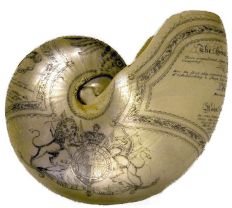Excavating the ‘Rutland Sea Dragon’, the largest ichthyosaur skeleton ever to be found in the UK! By Nigel Larkin.
Although fieldwork is the aspect I enjoy most about being a palaeontologist, proper excavations come along all too rarely. So it was with great delight, excitement and curiosity that on a very cold and misty day last February (2021) I met with my colleagues Dr Dean Lomax, Dr Mark Evans and Darren Withers at Rutland Water Nature Reserve (owned and run by Anglian Water) in the county of Rutland in the midlands. Some articulated vertebrae had been found by Joe Davis (Conservation Team Leader at Leicestershire and Rutland Wildlife Trust) when water levels had been lowered to undertake maintenance work and as he wasn’t sure what sort of animal they were from he did exactly the right thing and made sure they were not damaged whilst he sought relevant specialists to check their significance. A couple of ichthyosaur fossils had been found on the reserve before, and the famous ‘Rutland dinosaur’ had been found not far away. So, although finding some fossils was not completely unexpected, Joe realised that the discovery of a row of articulated vertebrae could be important. From Joe’s photos we were able to ascertain in advance that these were the remains of a large ichthyosaur – so, naturally we wanted to investigate for ourselves what had actually been found.


Above left: Our first visit to assess the specimen, on a cold winter day in February 2021 (left to right: Darren Withers, Dr Mark Evans, Dr Dean Lomax and Nigel Larkin). © Natalie Turner.
Above right: Months later, excavating the skeleton and making sturdy plaster jackets so that it could be lifted safely in sections. ©dean Lomax.
The ground was quite literally frozen beneath our feet as we walked over to the site, but we soon got warm removing the protective tarpaulin Joe had thoughtfully covered the bones with, and by trowelling away the wet clay that covered the rest of the specimen (Fig. 1). Initially, we had been presented with a dozen or so exposed vertebrae, and suspicious-looking lumps reaching out in both directions either side but had no idea if just a small portion of a skeleton had been preserved – as is normally the case – or if it would be more complete. We thought that the specimen might have had its tail destroyed or scattered by bulldozers when the lagoon had been dug out some ten years previously, not least because two ichthyosaur tail vertebrae were found quite some distance from the specimen.
Thankfully, those two tail bones turned out to be from a different skeleton as we soon uncovered ribs, a portion of the skull, and – amazingly – revealed an entire vertebral column down to the very tip of the tail where the vertebrae are the size of a penny. Incredibly, within a few hours we had uncovered what looked like an almost complete and well-preserved skeleton with all the bones still in association. Furthermore, it was huge! From our measurements it was immediately apparent that at about 10 metres long this was the largest ichthyosaur skeleton ever discovered in the whole of the British Isles, and also the most complete within that size range. We also had a suspicion that this would be the first definite example of the species Temnodontosaurus trigonodon to be found in the country – in fact it is almost unknown outside of Germany. We took hundreds of photos of the specimen for future reference and so that a 3D digital model could be made of the skeleton lying in the ground largely exposed. There was no possibility of excavating and lifting the whole skeleton there and then – it would take many people a few weeks to do such a job properly and it would be totally impractical to start such a task in cold, wet February with its short days. Also, the water levels needed to be raised imminently to maintain the right habitat for the migratory birds. As it began to get dark we covered the skeleton, protecting it carefully with sheets of thin plastic, the soft clay and then the tarpaulin and as we walked away in the dark we started to make plans for the full excavation of the specimen later in the year.
Hundreds of emails and many online meetings later, after various funding applications (several of which were frustratingly unsuccessful) and once an exhaustive risk assessment had been completed (involving the words ‘bird excrement’ far too many times for my liking but obviously focusing on Covid and the more usual potential dangers of fieldwork) a small but perfectly formed team assembled in late August. This was the time of year when we would least disturb the birdlife, as being a bird reserve was the main function of this part of the site. Also, it would correspondingly be a time when there would be fewest bird watchers. We needed to keep the excavation as secret as possible, so that it would not get raided by unscrupulous individuals overnight (sadly this does happen). The various hides around this part of the reservoir were shut to visitors for the duration of the dig. August sounded good to us when planning the excavation. It would be sunny and warm! We went to great lengths in the risk assessment to warn of sunburn, dehydration and heatstroke. As it turned out, we should have focused more on hypothermia, windburn and trenchfoot. We ended up wearing woolly hats and overcoats when digging on many of the days, the weather was so bad.


Above left: Dr Emma Nicholls wrapped up warm on a cold and damp August day, excavating bones of a forelimb. © Nigel Larkin. Above right: Just as well we all packed woolly hats, waterproofs, gloves and wellies for our summer holidays. © Nigel Larkin.
The excavation was led by Dr Dean Lomax and myself (Nigel Larkin). Dean is a globally recognised expert in ichthyosaur research who has a lot of excavation experience. He formulated the excavation plan, applied for funding, contacted relevant people who could be of assistance, put together the team, liaised with Anglian Water and orchestrated public engagement plans for filming the excavation as part of a TV show and the PR.
I am a palaeontological conservator with experience of excavating large, awkward and/or fragile specimens in difficult circumstances so I dealt with the on-site logistics: I devised the risk assessment and conservation strategy, obtained all the tools and materials we would need, and hired the Luton van that would transport all the materials and eventually the specimen. We were assisted in the planning and execution of the project by Dr Mark Evans, a marine reptile expert with an intimate knowledge of the local geology and palaeontology from his many years as Curator of Geology at Leicester Museums and Galleries. His local expertise was vitally important and, being local to the area, and considering the rules of the pandemic at the time, Mark was initially the first person to meet with Joe, immediately following the discovery, to examine the find and take photographs. Between us we have about 75 years’ relevant experience. Once on site, we were joined throughout the excavation by vertebrate palaeontologist Dr Emma Nicholls who is the Senior Curator of Natural Sciences at the Horniman Museum and Gardens in London. Emma and Mark combined their vast curatorial expertise and experience of fossil excavations to employ the methodologies I devised to catalogue and document the site, ensuring that no scientific data would be lost once the specimens were removed. We were also supported on site by a small team of colleagues and volunteers each of whom had specific skills they could bring to the excavation, including members of the Peterborough Geological and Palaeontological Group (Darren Withers, David Savory and Mick Beeson). For a full list of team members, see below. The team had to be small for several reasons: not only were we worried about the large articulated skeleton getting damaged by too many people being onsite before the fullest extent of the find was fully uncovered, but we had to take costs into consideration and we had strict policies regarding Covid: we all took Covid tests before we assembled, and took them regularly throughout the excavation. Even so, we all wore masks when sharing vehicles and when in the nearby visitor centre and made sure we didn’t share food or drink. We had a 5-litre pump-action Covid-killing hand gel set up on the site (that would also handily kill botulism and leptospirosis etc re the bird guano that was everywhere).

The first thing we had to do once back on site was to shovel away many months’ worth of bird poop then remove the old tarpaulin carefully and begin to expose the full extent of the skeleton. Then we gridded-out the site into 1-metre squares so that we could plot a good-old-fashioned 1:10 scale drawing of the skeleton on large sheets of graph paper. Once the skeleton had been fully cleaned as far as was practicable in field conditions with small brushes and trowels (Fig. 3), Steven Dey – a digital 3D imaging specialist at ThinkSee3D – undertook a detailed 3D scan of the specimen using photogrammetry so that a permanent record was made of the whole specimen in-situ before we removed any bones (Fig. 4).
The thousands of images he took have been turned into a very detailed 3D digital model that can be used for research, education and display purposes. You can see it here on Sketchfab: https://sketchfab.com/3d-models/ichthyosaur-temnodontosaurus-550fdd879dd849ffafd0e3426ee57f64
The hand-drawn scaled plot of the bones compliments this digital model as it has been annotated with the numbers of finds, etc. Importantly, the 3D digital model will act as a very useful reference when the skeleton is being removed from the plaster field jackets and the bones are cleaned and prepared.
Figure to the right: Dr Emma Nicholls shows off a recently discovered ichthyosaur tooth whilst in the background Dr Mark Evans cleans the pectoral girdle and Steven Dey of Thinksee3D starts the 3D scanning of the site using photogrammetry.© Nigel Larkin.
A significant part of the excavation was to understand the ancient environment in which the ichthyosaur lived and died. Whilst removing the clay from the bones, the team were careful to look out for and collect additional fossils in the associated matrix, which included numerous molluscs, principally ammonites and belemnites. In some cases, specimens lay directly on the bones. We also collected a wide variety of fossils found in the general vicinity, including ammonites and belemnites but also bivalves, nautili, gastropods, and several ichthyosaur vertebrae from other individuals, which further highlights the significance of the site and provides an insight into the ancient life of this small corner of Rutland.
Based on previous studies of the geology of Rutland Water, along with the index fossils found during the excavation, we know that this site dates from the Whitby Mudstone Formation of the Early Jurassic Toarcian Stage. However, to determine exactly which stratigraphic horizon the specimen comes from and therefore date the site more specifically, various samples of matrix were also collected to study microfossils. This part of the project was led by Dr Ian Boomer from the University of Birmingham. Analysing the samples, Dr Boomer discovered numerous microfossils which pinpointed the exact horizon in which the ichthyosaur is preserved and determined the age to be between 182 and 181.5 million years old.


Above left: The team cleaning up the skeleton during the first week of the excavation. © Dean Lomax. Above right: A trench was excavated around the skeleton so that the sturdy plaster jackets could be made to protect the specimen in sections. © Dean Lomax
My particular responsibility once on site was to look after the safety of the bones and devise the methods of recording and lifting the skeleton. As the ichthyosaur was being uncovered and cleaned it rapidly became apparent that although the bones have great surface detail, they are quite fragile. The ribs and skull in particular are heavily cracked but the skeleton was massive and would be heavy. The combination of these facts alone led us to determine that we should lift the whole skeleton in a series of plaster of Paris and hessian field jackets, strengthened with splints. But this decision was reinforced by the fact that the skeleton was incredibly well preserved in its entirety, down to the tip of the tail, and that it exhibited some really interesting taphonomic information (it had clearly been scavenged, possibly by other ichthyosaurs). We wanted to keep all of this information intact. Even though all the bones of the skeleton had been plotted and scanned, removing bones individually would erase their immediate context and association with one another. So, apart from a few vertebrae and limb bones that had been scattered quite far afield by natural processes after the animal’s death, the largest ichthyosaur skeleton ever found in the country was to be lifted in a series of unavoidably very heavy field jackets.
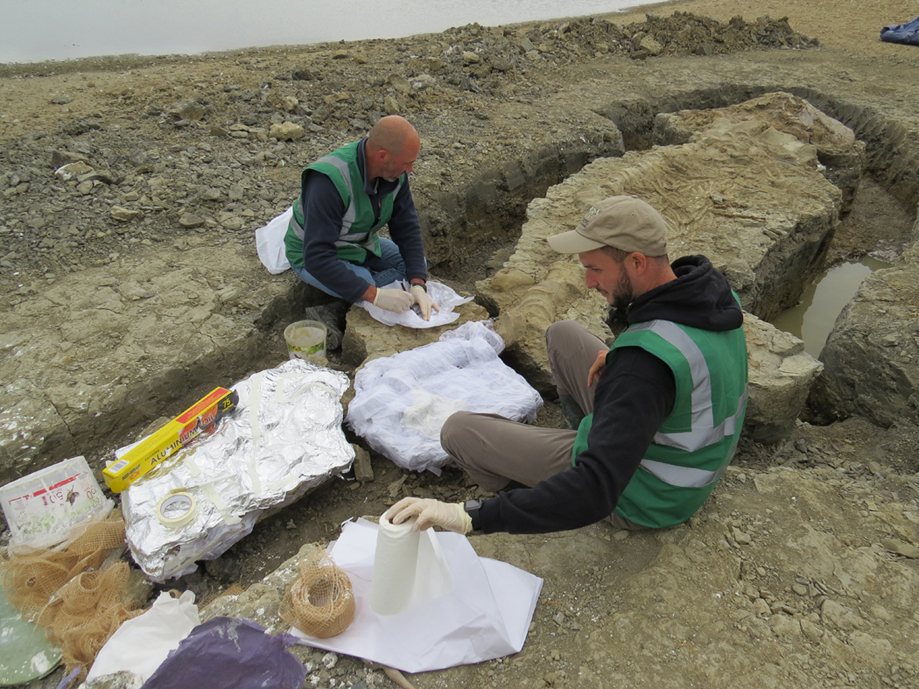
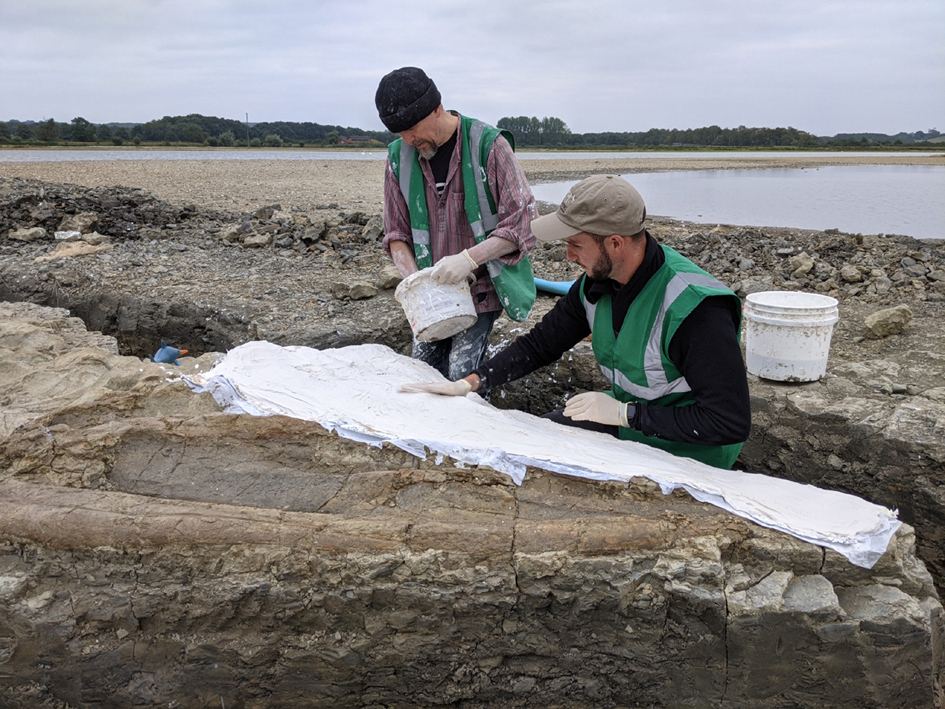
Above left: Dr Mark Evans and Dr Dean Lomax making plaster jackets for the proximal section of the tail. © Nigel Larkin. Above right: Nigel Larkin and Dr Dean Lomax start to make the plaster jacket for the large skull. © Dean Lomax.
This meant that we had to dig a deep trench right around the skeleton, to leave the fossil on a massive pedestal, then begin the laborious process of making the protective field jackets: first consolidating the bones; then adding layers of dampened tissue, followed by dry tissue; then foil; and then umpteen layers of plaster of Paris and hessian until the top and sides were covered. Then followed the difficult job of reducing the pedestals of matrix underneath, adding more plaster and hessian to the undersides and adding splints. The largest field jackets required a series of sturdy wooden batons securely screwed to one another underneath the plaster jacket so that we could lift the whole block with straps secured to the wood. It is difficult to describe the literal pain and effort that this involved, digging a series of tunnels right under the field jackets through the Jurassic clay and securing the wood, especially considering how muddy it got in the trenches. Also, we unfortunately experienced some problems with the plaster: the weather was cold and damp for much of the excavation, and we had a constant damp breeze flowing at us off the large reservoir. We hardy souls weren’t too bothered by this but it meant that on most days the plaster simply wouldn’t set properly. Also, the sheer size of the task presented difficulties. The field jacket containing the skull at 2 m long, and almost as wide, weighed just under a tonne.


Above left: The trenches around the specimen had to be quite large and deep to enable us to make the undersides of the plaster jackets as sturdy as possible. Here, Nigel Larkin tackles the underside of the skull. © Dean Lomax. Above right: The medium-sized jackets required wooden splints to provide extra rigidity. © Dean Lomax.
The field jacket containing the whole abdomen – almost 3 m by about 1.5 m – must easily weigh a tonne and half. Fortunately, we had a few days of good weather towards the end of the excavation when we were working on the largest field jackets and also Joe Davis had access to a tractor, telehandler and a large agricultural trailer. We certainly couldn’t have moved these field jackets by muscle power alone. It was a huge relief – to say the very least – when, after three weeks of us all working 12-hour days, these two massive jackets in particular were mechanically lifted by Joe on to the waiting trailers without any problems at all. It went perfectly.



Above top: The abdomen: our largest section containing the all-important stomach area and some portions of the forelimb. At about 3 m by 1.5 m, this field jacket would weigh in the region of 1.5 tonnes. © Dean Lomax. Above left: Making the field jacket for the large abdomen block: applying plaster to the undersides and reducing the size of the pedestal. © Dawn Butler. Above right: The 1.5 tonne field jacket ready to be lifted! © Emma Nicholls.
Months of planning, weeks of intense activity, and a lot of hard work and emotion had gone into making sure that all the bones were successfully recovered without any breakages or disassociation, and that everyone involved survived the experience with nothing more than aching muscles and dirty clothes along with their happy memories. Despite the long days, poor weather, difficult working conditions and sheer physicality of the tasks that faced us there was constant good-humoured banter, laughter and a knuckling-down to work that I have rarely witnessed. That’s what a world-class palaeontological find does to people!


Above left and right: The safe removal of the largest field jacket from the site. © Emma Nicholls.
Much of the excavation was filmed by ‘Posh Gecko’ so that there would be a fairly comprehensive video archive of the excavation for use by Anglian Water, Rutland County Council, Rutland Museum and any researchers in the future. Also, Dean Lomax arranged for some of the work to be captured by ‘Rare TV’ for the BBC series ‘Digging for Britain’, presented by Professor Alice Roberts in January 2021.
Much of the excavation was filmed by ‘Posh Gecko’ so that there would be a fairly comprehensive video archive of the excavation for use by Anglian Water, Rutland County Council, Rutland Museum and any researchers in the future. Also, Dean Lomax arranged for some of the work to be captured by ‘Rare TV’ for the BBC series ‘Digging for Britain’, presented by Professor Alice Roberts in January 2021. The whole specimen and all the associated invertebrate fossils are currently stored in my industrial unit (Fig. 16) at a secret location in north Shropshire. The next phase of work is to apply for funding for the 18-month project to remove the field jackets and prepare and conserve the contents for research and display. It is hoped that the conserved skeleton and associated fossils will be placed on permanent exhibition in an accredited institution very close to where the fossil was found, in Rutland itself.
Once the specimen is fully prepared, the team will be able to study the skeleton in more detail and publish various research papers. Based on our assessment in the field, our analysis still suggests that the skeleton is an example of the Early Jurassic apex predator Temnodontosaurus trigonodon, a species that is well-known from similar aged sites in Germany but has yet to be formally recognised in Britain, so this would extend the geographic range of the species significantly. This is a sensational fossil find. Britain is the birthplace of ichthyosaurs, their fossils having been unearthed and scientifically studied here for over 200 years, with the first scientific finds dating back to Mary Anning and her early discoveries in Lyme Regis on the Jurassic Coast. Yet, despite the thousands of ichthyosaurs discovered in Britain, none of them are quite as large as this specimen and few examples of this genus been found in the UK that are this complete. Rutland’s motto ‘Multum in Parvo’ translates as ‘Much in Little’ so it is fitting that we have found Britain’s largest ichthyosaur skeleton in England’s smallest county. In fact, not only is it the largest ichthyosaur skeleton ever found in Britain, it is also the most complete skeleton of a large prehistoric reptile ever discovered in the UK. And yes, that includes dinosaurs. It is a truly unprecedented discovery and one of the greatest finds in British palaeontological history.
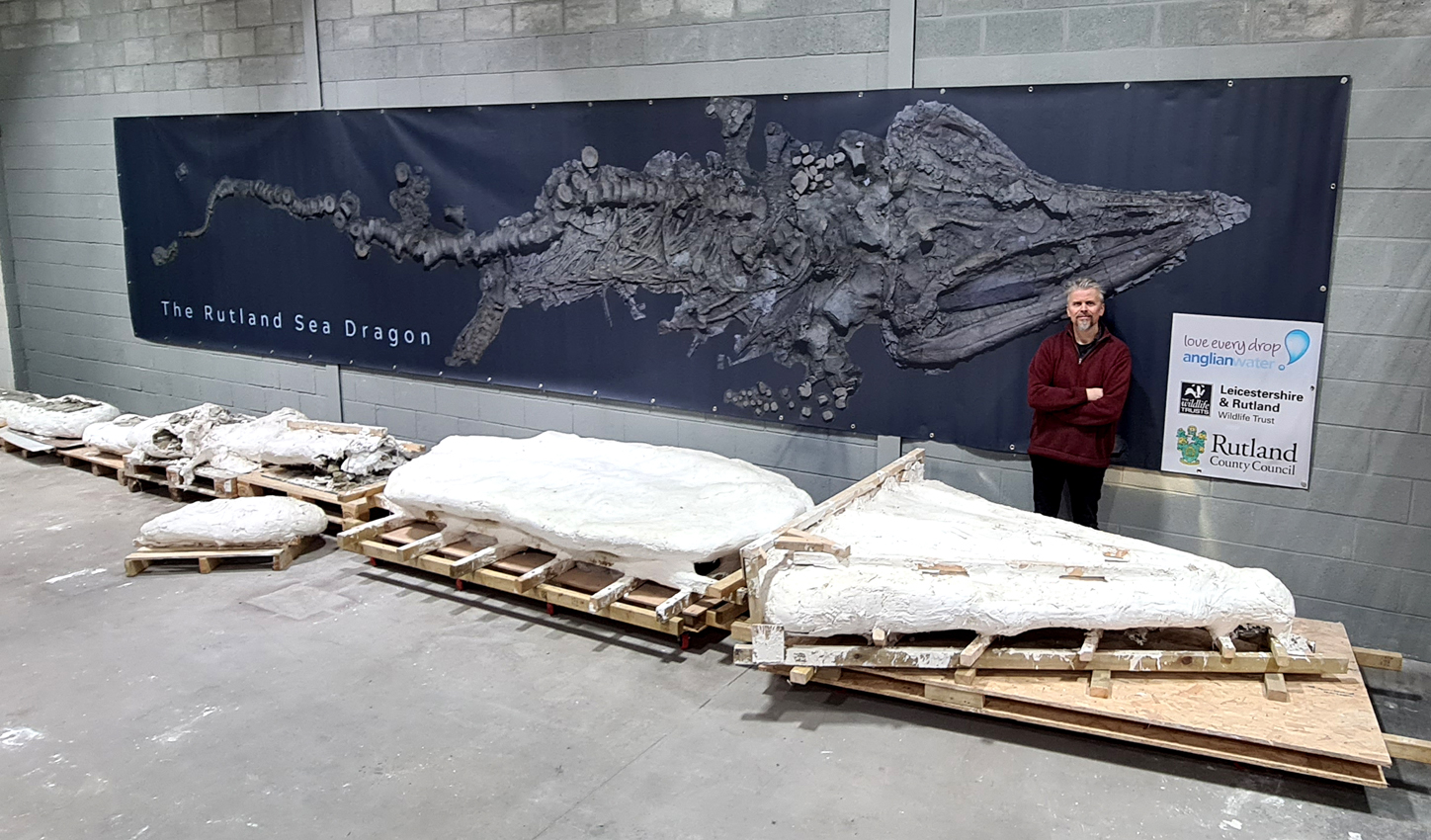
Above: The ichthyosaur skeleton in its field jackets in Nigel’s conservation workshop (human for scale). On the wall is a life-size 2D print out of Steven Dey’s 3D digital model of the skeleton as it lay in the ground after cleaning. A very useful guide to be used during the 18-month project to clean and conserve the bones. ©Nigel Larkin.
Acknowledgements: The excavation was organised by Dr Dean Lomax (University of Manchester) and Nigel Larkin (University of Reading) assisted by Dr Mark Evans (British Antarctic Survey and University of Leicester). Helping us with the excavation were: Dr Emma Nicholls (Horniman Museum and Gardens); Darren Withers, David Savory and Mick Beeson (of the Peterborough Geological and Palaeontological Group (Figure 17)); Emily Swaby (the Open University); Paul de la Salle (The Etches Collection) and Carol Skiggs. Dr Ian Boomer (University of Birmingham) and Dr Tom Harvey (University of Leicester) took samples for assessing the microfossils to date the site. The 3D scanning and building of the digital 3D model was undertaken by Steven Dey of ThinkSee3D. Phil Rye made the scale drawing of the skeleton. Vicky Ward (University of Leicester) was involved in contacting the right specialists straight after the find was made by Joe Davis. Ichthyosaur cake (yes, you read that right), humorous anecdotes and fossils from around the site were provided by Dawn Butler and Matthew Butler (on site for two days as a student volunteer placement); a nd Joelle Woolley (Anglian Water) also found many invertebrate fossils and kept us entertained but more importantly provided the great lunches. The excavation could not have taken place without the kind assistance of the Rutland and Leicestershire Wildlife Trust, Anglian Water and Rutland County Council (we would especially like to thank Joe Davis, Joelle Woolley, Jake Williams, Claire Hornsby, Robert Clayton and Ari Volanakis for all of their hard work and enthusiasm in helping to make this happen). Funding was provided by Anglian Water, The Pilgrim Trust, the Rutland and Leicestershire Wildlife Trust, Rutland County Council, The Geologists Association’s Curry Fund and the Palaeontographical Society.

Above: Help from members of the Peterborough Geological and Palaeontological Group was invaluable. Left to right: Mick Beeson, David Savoury and Darren Withers pose next to the large ichthyosaur skull. ©Dean Lomax.


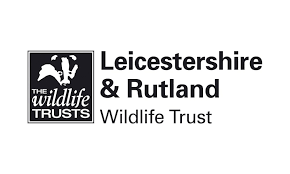
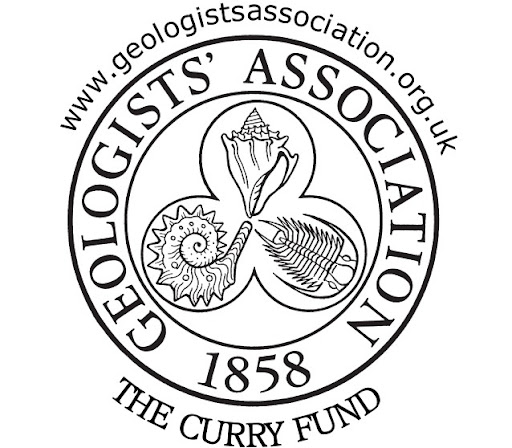


For more details about what we can do for you, or for a quote, please
contact:
enquiries@natural-history-conservation.com
We
are members of the United Kingdom Institute for Conservation of Historic and
Artistic Works
